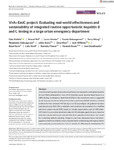2022-03-31Zeitschriftenartikel
VirA+EmiC project: Evaluating real-world effectiveness and sustainability of integrated routine opportunistic hepatitis B and C testing in a large urban emergency department
Nebbia, Gaia
Ruf, Murad
Hunter, Laura
Balasegaram, Sooria
Wong, Terry
Kulasegaram, Ranjababu
Surey, Julian
Khan, Zana
Williams, Jack
Karo, Basel
Snell, Luke
Flower, Barnaby
Evans, Hannah
Douthwaite, Sam
Innovative testing approaches and care pathways are required to meet global hepatitis B virus (HBV) and hepatitis C virus (HCV) elimination goals. Routine blood-borne virus (BBV) testing in emergency departments (EDs) in high-prevalence areas is suggested by the European Centre for Disease Prevention and Control (ECDC) but there is limited evidence for this. Universal HIV testing in our ED according to UK guidance has been operational since 2015. We conducted a real-world service evaluation of a modified electronic patient record (EPR) system to include opportunistic opt-out HBV/reflex-HCV tests for any routine blood test orders for ED attendees aged ≥16 years. Reactive laboratory results were communicated directly to specialist clinical teams. Our model for contacting patients requiring linkage to care (new diagnoses/known but disengaged) evolved from initially primarily hospital-led to collaborating with regional health and community service networks. Over 11 months, 81,088 patients attended the ED; 36,865 (45.5%) had a blood test. Overall uptake for both HBV and HCV testing was 75%. Seroprevalence was 0.9% for hepatitis B surface antigen (HBsAg) and 0.9% for HCV antigen (HCV-Ag). 79% of 140 successfully contacted HBsAg+patients required linkage to care, of which 87% engaged. 76% of 130 contactable HCV-Ag+patients required linkage, 52% engaged. Our results demonstrate effectiveness and sustainability of universal ED EPR opt-out HBV/HCV testing combined with comprehensive linkage to care pathways, allowing care provision particularly for marginalized at-risk groups with limited healthcare access. The findings support the ECDC BBV testing guidance and may inform future UK hepatitis testing guidance.
Dateien zu dieser Publikation

